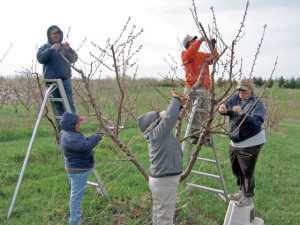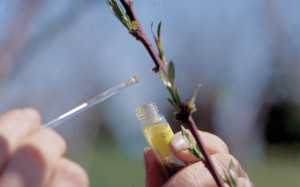Lessons Learned From Mother Nature In Peach Breeding
“You can observe a lot just by watching.” — Yogi Berra
One of my many roles as an Extension specialist has been to guide the peach breeding program co-funded by Michigan State University and the Michigan Peach Sponsors, a non-profit peach industry organization. At first look, peach breeding looks simple; it has been done by bees and other insects since flowers evolved millions of years ago. But I have found that a keen eye helps when humans become marriage counselors to peach trees.
Breeding Goes To The Dogs
The traditional method of peach breeding starts with emasculating the peach flower so that we can substitute pollen from another source — an arranged marriage, so to speak. Although simple to do, this is the big bottleneck of peach breeding. Removing the petals from thousands of flowers on a tree takes tremendous patience.
Various flower-cutting devices have been devised over the years, including modified hacksaw blades, tweezers, and even cultish-looking, carefully manicured notched fingernails. My own solution was to use a rattail file and hacksaw, and later a Dremel power grinder to modify sewing scissors for blossom work. I learned much later from a dog-owner friend that cheap toenail clipping scissors designed for dogs were available, and found that they work just fine for peach breeding. You never know where a conversation may lead.
Wait For It, Wait For It

A farm crew at the Southwest Research and Extension Center in Benton Harbor, MI, preps for making peach crosses (Photo credit: Bill Shane).
In my early gung ho days of peach breeding, I would send out our farm crew with ladders in the early hours to make crosses. The workers would stand on stepladders, wearing jersey gloves, and shivering in the low 50°F temperatures. They would watch thermometers as the sun rose higher, waiting for temperatures to reach the upper 50s, the minimum temperature for making crosses. It turns out that nature provides some clues here.

Applying pollen to the pistil of a peach blossom with a glass rod. (Photo credit: Bill Shane)
We discovered that when the temperatures are high enough for successful crossing, the tip of the pistil oozes a sticky substance that traps pollen. At that time, our workers could see that the glass rods they used to dab pollen on the stigma would turn yellow from pollen stuck on the ooze. Even simpler was to watch the bees. We found that bees started to nose around the dandelions on the orchard floor at about the same time the peach flowers became receptive to pollen.
Nubbin Fruit Explained
Our breeding work gave some insight into a cause of “nubbins” — peewee-sized fruit that never become full sized. In cool spring years our breeding crews emasculated flowers in the morning, hoping for warmer temperatures later when the crew could dab pollen on the flowers. Sometimes, the warmer temperatures did not occur until the following day, at which time the crew would apply pollen. The number of nubbin fruit would be higher when pollen was applied late.
We also came to expect nubbin fruit for varieties such as Glohaven with tiny, delicate thin styles (the stalk of the pistil) that are prone to dehydration before successful pollination. We learned the virtue of patience. We learned, from the bees, to wait until the flowers were receptive, and then do as many emasculations followed immediately by pollination. Some plant breeders do their pollination work in heated buildings or tents, avoiding these temperature problems.
Smaller Is Better
Split pits in fruit are a nuisance to the grower and to the peach breeder. Peach fruit with split pits are prone to rot problems which ruin the fruit for the grower and the seed needed by the breeder. Although there are exceptions, in general, we have observed over the years that peach varieties with smaller pits tend to be less prone to split pit problems. My personal theory is that a smaller pit provides less attachment points and leverage for the cracking action by the flesh of the expanding fruit.
Accordingly, whenever practical, in our breeding program, we use the variety with smaller pits as the mother parent in a cross combination to help reduce split pit problems. It’s a simple switch, but it greatly increases the number of viable seed we get from a cross. It’s a matter of simple observation and thinking about what is going on. It’s part of what makes my job interesting.










